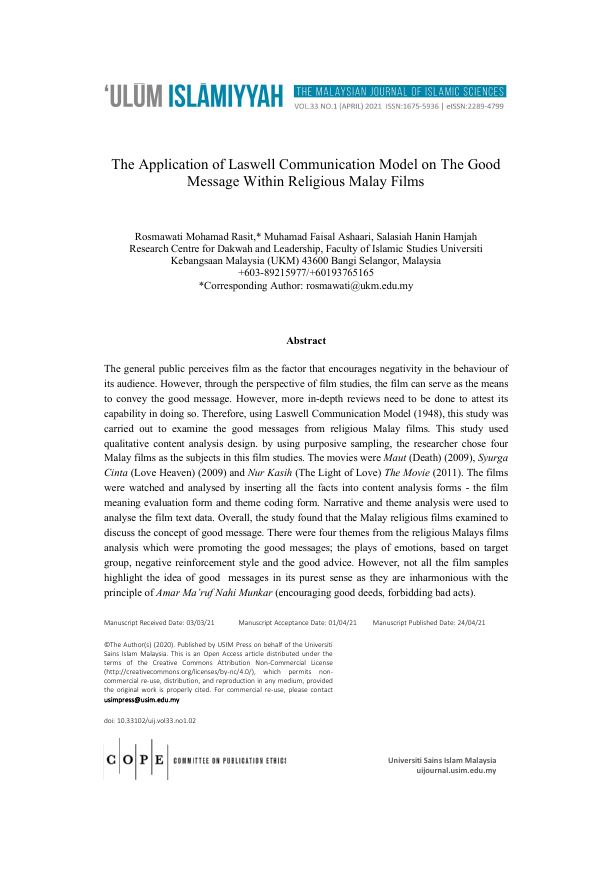The Application of Laswell Communication Model on The Good Message Within Religious Malay Films
DOI:
https://doi.org/10.33102/uij.vol33no1.273Keywords:
Lasswell Communication Model, Good message, film, religious film, Malay StudiesAbstract
The general public perceives film as the factor that encourages negativity in the behaviour of its audience. However, through the perspective of film studies, the film can serve as the means to convey a good message. However, more in-depth reviews need to be done to attest to its capability in doing so. Therefore, using Laswell Communication Model (1948), this study was carried out to examine the good messages from religious Malay films. This study used qualitative content analysis design. by using purposive sampling, the researcher chose four Malay films as the subjects in this film study. The movies were Maut (Death) (2009), Syurga Cinta (Love Heaven) (2009) and Nur Kasih (The Light of Love) The Movie (2011). The films were watched and analysed by inserting all the facts into content analysis forms - the film meaning evaluation form and theme coding form. Narrative and theme analysis were used to analyse the film text data. Overall, the study found that the Malay religious films examined to discuss the concept of good message. There were four themes from the religious Malays films analysis which were promoting the good messages; the plays of emotions, based on the target group, negative reinforcement style and the good advice. However, not all the film samples highlight the idea of good messages in their purest sense as they are inharmonious with the principle of Amar Ma’ruf Nahi Munkar (encouraging good deeds, forbidding bad acts).
Downloads
References
Ab. Aziz Mohd Zin, Nor Raudah Siren, Yusmini Md Yusoff, Faridah Mohd Sairi & Mohd Anwarulhaq Sulaiman. (2006). Dakwah Islam Di Malaysia. Kuala Lumpur: Penerbit Universiti Malaya.
Abd. Aziz Itar. (2007). Perbanyakkan Filem Berunsur Keislaman. Utusan Malaysia, 12 December.
Ahmad Nuril Huda. (2012). Negotiating Islam with Cinema. Wacana, 14 (1), 1-16.
Bandura, Albert. (2001). Social cognitive theory of mass communications. Media Psychology, 3 (3), 265-299. doi: 10.1207/S1532785XMEP0303_03
Bandura, Albert. (2005). The evolution of social cognitive theory. Dlm. Smith, K.G. & Hitt, M.A. (Ed.), Great minds in management. (hlm. 9-35). Oxford: Oxford University Press. Diakses daripada http://www.des.emory.edu/mfp/Bandura2005.pdf
Elo, Satu. & Kyngas, Helvi. (2007). The Qualitative Content Analysis Process. Journal of Advanced Nursing 62 (1), 107-115. Doi: 10.1111/J.1365-2648.2007.04569
Elo, Satu., Kaarianen, Maria., Kanste, Outi., Polkki, Tarja., Utriainen, Kati. and Kyngas, Helvi. (2014). Qualitative content analysis: a focus on trustworthiness. SAGE Open, 1-10.
Flensburg, Per. (2009). An Enhanced Communication Model. The International Journal of Digital Accounting Research Vol. 9, Pp. 31-43.
Al-Ghazali. (2000). Ihya’ ‘Ulum Al-Din. Kaherah: Dar Al-Taqwa Li Al-Turath.
Kubrak, Tina. (2020). Impact of films: changes in young people’s attitudes after watching a movie. Behavioral Sciences, 10 (5), 86-98.
Laswell, Harold. (1948). The Structure And Function of Communication In Society. In Bryson, L. (Ed.), The Communication Of Ideas, 37-51. New York: Harper.
Md Salleh Hj. Hassan, Mohd Nizam Osman dan Zoheir Sabaghpour Azarian. (2009). Effects of watching violence movies on the attitudes concerning aggression among midle schoolboys at International School in Kuala Lumpur. European Journal of Scientific Research, 38 (1), 141-156.
Merriam, Sharan B. (2001). Qualitative Research And Case Study Application In Education. San Francisco: Josey-Bass Pub.
Mohd Arif Ismail, Mohd Jasmy Abd Rahman, Maimun Aqsha Lubis & Rosnaini Mahmud. (2009). Pendidikan Islam Melalui Penggunaan Filem Dalam Pengajaran Dan Pembelajaran. Prosiding Wacana Pendidikan Islam Siri Ke-7 Peringkat Nusantara.
Naim Ahmad. (2011). Filem Islam satu pembicaraan. Shah Alam: Uni-N Production Sdn. Bhd.
Nascimento, Jonas Do. (2019). Art, Cinema and Society: Sociological Perspectives. Global Journal of Human-Social Science, 19 (5), 19-28.
Noraini Idris. (2010). Penyelidikan Dalam Pendidikan. Malaysia: Mcgraw-Hill.
Rosmawati Mohamad Rasit, Salasiah Hanin Hamjah, Azimah Misrom and Nur Hikmah Yahya. (2019). Socio-cultural Discourse of Muslim Society in Social Semiotics Aspect of Advertising Text in Malaysia. Humanities & Social Sciences Reviews, 7 (5), 256-263.
Al-Qaradhawi, Yusuf. (1978). Thaqafah Al-Dai’yah. Beirut: Mu'assasat Al-Risalah.
Rosmawati Mohamad Rasit and Azimah Misrom. (2016). Analisis Elemen Patuh Syariah dalam Filem Nur Kasih the Movie (2011) Berdasarkan Teori Filem ar-Risalah. Jurnal Komunikasi Malaysian Journal of Communication 32 (1), 1-21.
Saodah Wok, Rizalawati Ismail and Nor Faridah Abdul Manaf. (2014). Impact of Islamic Film on Understanding of Islamic Values and Cultures for a Multiracial Society in Malaysia. International Journal of Science Commerce and Humanities, 2 (5), 161-174.
Sapienza, Zachary and Iyer, Narayanan. (2015). Reading Laswell’s Model of Communication Backward: Three Scholarly Misconceptions. Mass Communication & Society, 18 (5), 599-622.
Smets, Kevin. (2012). Connecting Islam and Film Culture: The Reception of the Message (ar Risalah) among the Moroccan Diaspora. Journal of Audience & Reception Studies, 9 (1), 68-93.
Smithikrai, Chuchai (2016). Effectiveness of Teaching with Movies to Promote Positive Characteristics and Behaviors. Procedia Social and Behavioral Science, 217, 522-530.
Zulkefli Aini and S. Salahuddin Suyurno. (2014). Hubungan antara Pendakwah dengan Mad’u dalam Komunikasi Insan. Paper presented at International Conference on Human Sustainability, organized by Universiti Tun Hussein Onn Malaysia, 9-10 April.
Zulkiple Abd. Ghani. (2003). Islam, Komunikasi Dan Teknologi Maklumat. Kuala Lumpur: Utusan Publications & Distributors Sdn. Bhd.

Downloads
Published
How to Cite
Issue
Section
License
Copyright (c) 2021 ROSMAWATI MOHAMAD RASIT, MUHAMAD FAISAL ASHAARI, SALASIAH HANIN HAMJAH

This work is licensed under a Creative Commons Attribution-NonCommercial 4.0 International License.
If the article is accepted for publication, the copyright of this article will be vested to author(s) and granted the journal right of first publication with the work simultaneously licensed under the Creative Commons Attribution-NonCommercial 4.0 International License, unless otherwise stated. Anyone may reproduce, distribute, translate and create derivative works of this article (for both commercial and non-commercial purposes), subject to full attribution to the original publication and authors. The full terms of this licence may be seen at https://creativecommons.org/licenses/by-nc/4.0/.






